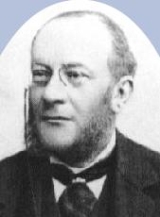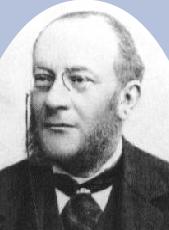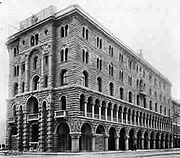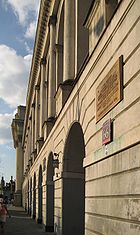
Wawelberg
Encyclopedia

Congress Poland
The Kingdom of Poland , informally known as Congress Poland , created in 1815 by the Congress of Vienna, was a personal union of the Russian parcel of Poland with the Russian Empire...
.
Name
The House of Wawelberg, The Wawelberg Bank (Банкирский Дом Вaвельбергов, "Вавельбергъ")Hyppolite Wawelberg (Russian Ипполит Адреевич Вавельберг, Polish Hipolit Wawelberg)
Michail Wawelberg (Russian Михаил Ипполитович Вавельберг)
Hyppolite Wawelberg

Bank
A bank is a financial institution that serves as a financial intermediary. The term "bank" may refer to one of several related types of entities:...
had its origins in a loan
Loan
A loan is a type of debt. Like all debt instruments, a loan entails the redistribution of financial assets over time, between the lender and the borrower....
office
Office
An office is generally a room or other area in which people work, but may also denote a position within an organization with specific duties attached to it ; the latter is in fact an earlier usage, office as place originally referring to the location of one's duty. When used as an adjective, the...
that began operating in the early 1840s. In 1869 young Hyppolite Wawelberg moved to St. Petersburg where he launched a new venture, the Wawelberg Bank. Hyppolite Wawelberg's Polish-Jewish connections (Wawelbergs were Jewish) remained strong, and the bank
Bank
A bank is a financial institution that serves as a financial intermediary. The term "bank" may refer to one of several related types of entities:...
was generally known as having two separate centers - in Warsaw
Warsaw
Warsaw is the capital and largest city of Poland. It is located on the Vistula River, roughly from the Baltic Sea and from the Carpathian Mountains. Its population in 2010 was estimated at 1,716,855 residents with a greater metropolitan area of 2,631,902 residents, making Warsaw the 10th most...
and in St. Petersburg. The first location of Wawelberg Bank was 25 Nevsky Prospekt
Nevsky Prospekt
Nevsky Avenue |Prospekt]]) is the main street in the city of St. Petersburg, Russia. Planned by Peter the Great as beginning of the road to Novgorod and Moscow, the avenue runs from the Admiralty to the Moscow Railway Station and, after making a turn at Vosstaniya Square, to the Alexander...
in St. Petersburg (House of the Parish of Our Lady of Kazan Cathedral, now housing Stockmann
Stockmann
Stockmann is a Finnish listed company which was established in 1862 and is engaged in the retail trade. Stockmann's three divisions are the department store division, Hobby Hall, which specialises in mail order and online sales, and Seppälä, a chain of fashion stores...
department store and SAS - Scandinavian Airlines System offices). Hyppolite Wawelberg made a fortune in Russia
Russia
Russia or , officially known as both Russia and the Russian Federation , is a country in northern Eurasia. It is a federal semi-presidential republic, comprising 83 federal subjects...
though he was equally well known as a generous philanthropist.
The new Polish Kingdom
Congress Poland
The Kingdom of Poland , informally known as Congress Poland , created in 1815 by the Congress of Vienna, was a personal union of the Russian parcel of Poland with the Russian Empire...
, as created by the Congress of Vienna
Congress of Vienna
The Congress of Vienna was a conference of ambassadors of European states chaired by Klemens Wenzel von Metternich, and held in Vienna from September, 1814 to June, 1815. The objective of the Congress was to settle the many issues arising from the French Revolutionary Wars, the Napoleonic Wars,...
, was a Polish entity but was in personal dynastic union
Personal union
A personal union is the combination by which two or more different states have the same monarch while their boundaries, their laws and their interests remain distinct. It should not be confused with a federation which is internationally considered a single state...
with Imperial Russia, since the reigning Romanov
Romanov
The House of Romanov was the second and last imperial dynasty to rule over Russia, reigning from 1613 until the February Revolution abolished the crown in 1917...
tsar
Tsar
Tsar is a title used to designate certain European Slavic monarchs or supreme rulers. As a system of government in the Tsardom of Russia and Russian Empire, it is known as Tsarist autocracy, or Tsarism...
was also king of Poland. Though based in St. Petersburg, the Wawelbergs were instrumental to the development of finance in the Polish Kingdom. They were to Congress Poland what the Medici
Medici
The House of Medici or Famiglia de' Medici was a political dynasty, banking family and later royal house that first began to gather prominence under Cosimo de' Medici in the Republic of Florence during the late 14th century. The family originated in the Mugello region of the Tuscan countryside,...
s were to Florence, the Fugger
Fugger
The Fugger family was a historically prominent group of European bankers, members of the fifteenth and sixteenth-century mercantile patriciate of Augsburg, international mercantile bankers, and venture capitalists like the Welser and the Höchstetter families. This banking family replaced the de'...
s to Augsburg, the Rothschild
Rothschild family
The Rothschild family , known as The House of Rothschild, or more simply as the Rothschilds, is a Jewish-German family that established European banking and finance houses starting in the late 18th century...
s to France, and the Mellon
Mellon
- People :* Ailsa Mellon Bruce , daughter of Andrew William Mellon, philanthropist* Alfred Mellon , British composer and conductor* Andrew W. Mellon , one of the longest serving U.S. Treasury Secretaries in history...
s to the late-19th-century United States.

Russian nobility
The Russian nobility arose in the 14th century and essentially governed Russia until the October Revolution of 1917.The Russian word for nobility, Dvoryanstvo , derives from the Russian word dvor , meaning the Court of a prince or duke and later, of the tsar. A nobleman is called dvoryanin...
. He was also a member of the management
Management
Management in all business and organizational activities is the act of getting people together to accomplish desired goals and objectives using available resources efficiently and effectively...
board of the Warsaw Bank of Commerce (Bank Handlowy w Warszawie). Back in St. Petersburg he was a member of the treasury of the Jewish Colonist Society, honorable member of the Jewish Educational Society (Общество распространения просвещения среди евреев) and benefactor of the Roman Catholic Beneficial Society (Римско-католического благотворительное общества).
In 1875, in Warsaw, Poland, Hyppolite Wawelberg co-founded the Museum of Industry and Agriculture
Museum of Industry and Agriculture
The Museum of Industry and Agriculture is a museum of technology at Krakowskie Przedmieście 66 in Warsaw, Poland.-History:It was founded in 1866, chartered on June 5, 1875, opened in 1905, and destroyed in 1939 during World War II. From 1881 it was housed on Krakowskie Przedmieście in a former...
(Muzeum Przemysłu i Rolnictwa w Warszawie). It was in a physics laboratory there that, in 1890–91, Maria Skłodowska (Marie Curie), future investigator of radioactivity and future double Nobel laureate, did her first scientific work.
In 1895 Hyppolite Wawelberg founded the Warsaw Mechanical-Technical School with his faithful friend and collaborator, Stanislav Rotwand (Cтанислав Ротванд, Stanisław Rotwand), an 1860 alumnus of the University of Saint Petersburg law school.
Michael Wawelberg
Michael Wawelberg (Михаил Ипполитович Вавельберг; 1880 – after 1929) received a classical educational at the St. Nicholas Imperial Gymnasium in Tsarskoe Selo (Царскосельская Императорская Николаевская гимназия), from which he graduated in 1899. His father Hyppolite Wawelberg donated 500 roubles for the gymnasium's own charity, which at the time was a considerable sum of money.in 1903 Michael Wawelberg graduated from the University of St. Petersburg law school. That year he also took over the management of the Wawelberg Bank, which in 1912 was renamed the St. Petersburg Commercial Bank (Петербургский Торговый банк). In 1913 a branch was founded in Poland and became a publicly-traded company – the Western Bank (Bank Zachodni) in Poland). The Wawelbergs later lost control of it due to Russian Bolshevik-induced turmoil, but the bank survived all the 20th-century troubles. In 2001 it merged with the Great Polish Credit Bank (Wielkopolski Bank Kredytowy) and changed its name to Bank Zachodni WBK. Later it became part of the Allied Irish Banks
Allied Irish Banks
Allied Irish Banks p.l.c. is a major commercial bank based in Ireland.AIB is one of the so called "big four" commercial banks in the state. The bank has one of the largest branch networks in Ireland; only Bank of Ireland fully rivals it. AIB offers a full range of personal and corporate banking...
and is still one of the largest banks in Poland.
In 1910 the St. Petersburg Commercial Bank
Bank
A bank is a financial institution that serves as a financial intermediary. The term "bank" may refer to one of several related types of entities:...
purchased a building
Building
In architecture, construction, engineering, real estate development and technology the word building may refer to one of the following:...
with a lot underneath it in one most prestigious locations, at the corner of Nevsky Prospekt
Nevsky Prospekt
Nevsky Avenue |Prospekt]]) is the main street in the city of St. Petersburg, Russia. Planned by Peter the Great as beginning of the road to Novgorod and Moscow, the avenue runs from the Admiralty to the Moscow Railway Station and, after making a turn at Vosstaniya Square, to the Alexander...
and aristocratic Malaia Morskaia ulitsa (7 and 9 Nevsky Prospekt). The bank declared an open competition for the construction of the building
Building
In architecture, construction, engineering, real estate development and technology the word building may refer to one of the following:...
. The competition was won by young Russia
Russia
Russia or , officially known as both Russia and the Russian Federation , is a country in northern Eurasia. It is a federal semi-presidential republic, comprising 83 federal subjects...
n architect Marian Peretiatkovich (Peretyatkovich).
Naom Sindalovskii quotes a telling local St. Petersburg legend about building's construction. According to the legend after the building was constructed and the client (Michael Wawelberg) inspected it and could not find any deficiency with the work, he ordered to change the doors anyway because the door sign said "push." That's not what I do in life, said Wawelberg, I only pull things toward myself.
In 1917 on the eve of the Bolshevik putsch Michael Wawelberg lived in Czarskoe Selo at 66 Boulvardnaia ulitsa (66 Boulevard Street, ул. Бульварая, 66, Soviet name Октябрьский бульвар, Oktiabr'skii Boulevard). He was the chairman of the Commercial Bank and director of the board of Donetsk and Grushev Coal and Anthracite Mines (директор правления Донецко-Грушевского акционерного общества каменно-угольных и антрацитовых копий).
He fled Russia after 1917 and then disappears from the public view. Most likely he settled in Poland or spent some time there, because in Andrei Serkov's book on Russian Free Masonry he mentions that two free masons, Alexander Erdman and Michael Wawelberg (М. И. Вавельберг), as they considered themselves Russian, petitioned Grand Manster of the Polish Lodge with a request to allow them to found the Russian Lodge in Warsaw.
In St. Petersburg the Wawelbergs are best remembered because of the Wawelberg Bank building
Wawelberg Bank building
The Wawelberg Bank Building in St. Petersburg, Russia was built by the Wawelbergs - a prominent Imperial Russian banking family. Although this building bears initials HW , it was commissioned by his son, Michael Wawelberg...
still popularly known as the House of Wawelberg (Дом Вавельберга) at 7/9 Nevsky Prospekt.

